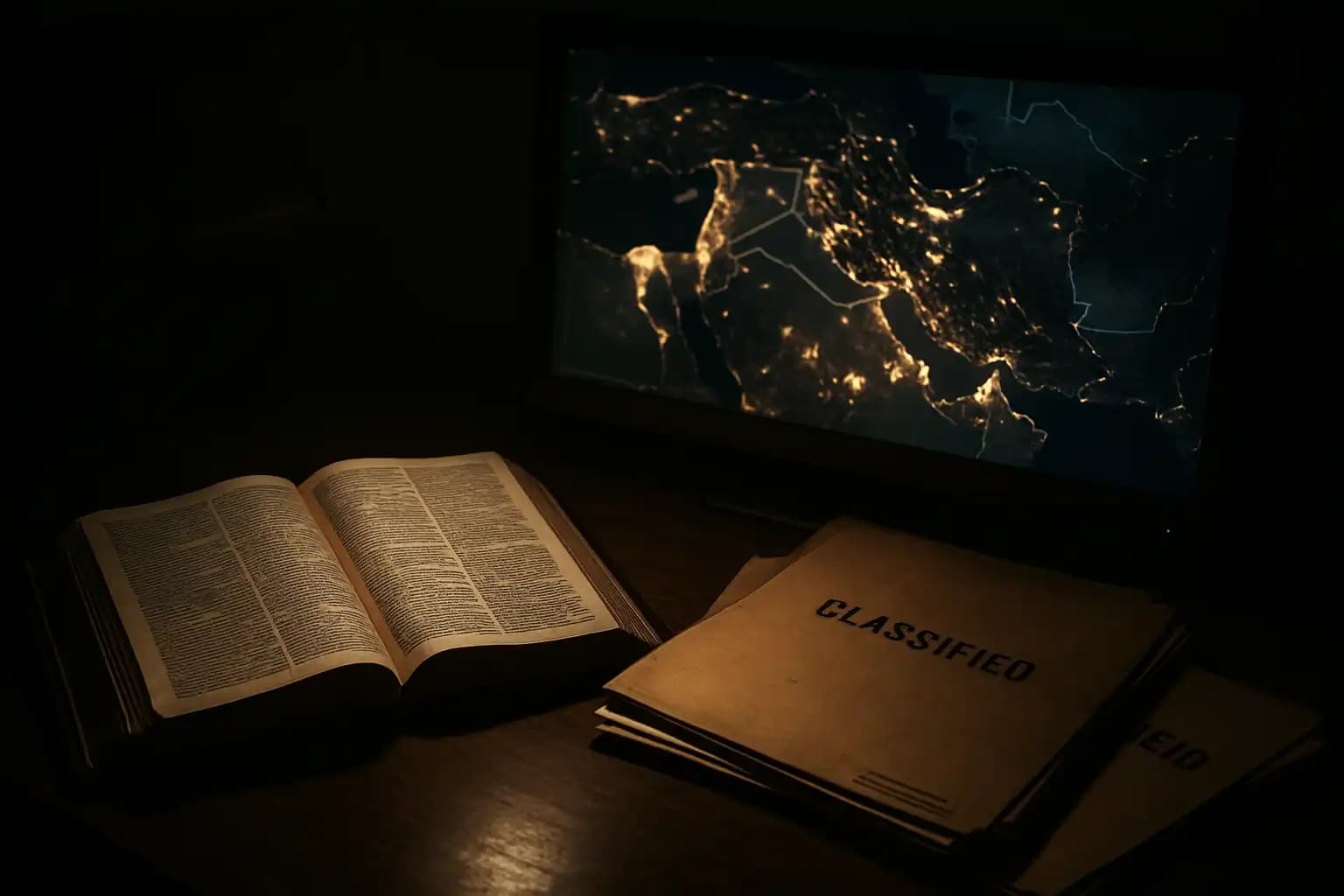The Central Intelligence Agency traffics in facts, not faith. When retired case officer Andrew Bustamante told a podcast audience that a specific biblical prophecy is real, listeners eagerly searched for documents. Bustamante outlined how operatives weigh Ezekiel’s visions like satellite imagery: as potential threat indicators.
This idea isn’t new—Langley veterans recall a 1991 white paper titled “A Bible Lesson on Spying,” first reported by the Washington Post. Bustamante’s on-record confirmation resonates today as prophecy hashtags can move markets faster than missiles. His remarks come just as 2025, a date promoted by sites like countdown-to-2025-07202024, enters the geopolitical discourse.
Ex-CIA Officer Turns Bible Code into Intel Briefing
Bustamante, whose tradecraft is detailed in Business Insider, told viewers of a viral YouTube interview that Ezekiel 38—Gog and Magog—appears in classified scenario planning “more often than civilians would guess.” Analysts track how millions of believers might react if they think the final war is underway, without assuming divine authorship.
This psychological aspect is vital for preventing surprise attacks. If a theocratic regime sees regional tremors as apocalyptic signs, missile inventories can vanish overnight. CIA behavioral teams audit prophecy discourse like Wall Street cites Fed statements. Bustamante’s candor merely lifts the blackout curtain.
His comments align with scholarly discussions about Langley’s religion desk. Declassified memos reveal analysts flagging eschatological language before Iran’s ballistic tests and North Korea’s satellite launches. One redacted telegram—quoted in intelligence forums and dissected on seconds-before-midnight-07112024—linked militia mobilizations in Iraq to a local cleric’s sermon on Gog’s impending raid. Thus, prophecy isn’t a joke inside HQ; it’s a variable.
From Langley Tradecraft to the Book of Ezekiel
Ezekiel’s end-times list—led by the mysterious Gog—resembles a modern strategic challenge: a coalition from “the far north,” allies in the Middle East, and an assault on Israel. Biblical literalists assign today’s capitals to those ancient figures, creating a predictive map that generals cannot ignore. The CIA connects human intent to hardware trajectories and extracts those predictions for early warning signals.
Some intellectual heavy lifting is outsourced. Contractors analyze social media for spikes in scriptural keywords, cross-referencing them with logistics flows and satellite heat signatures. When Russian armored columns approached Ukraine in 2022, one model noted a surge in Ezekiel-related hashtags among Slavic evangelical circles—a statistical anomaly highlighted in private data later analyzed on flashpoint-himalayas-07202024.
The open-source layer extends to academia. Experts in ancient Near Eastern literature, cited in journals after the Gulf War, brief analysts on the cultural significance of apocalyptic stories. As one Langley note reportedly quipped, “Missiles rust; myths endure.” This persistence explains why the agency still commissions reports on Gog and Magog while purchasing next-gen AI to process terabytes of drone footage.
Prophecy Fever and Intelligence Analysis
Critics argue that using scripture in threat matrices veers into pseudoscience. However, this practice reflects a reliable strategy: track belief, as belief drives action. During the Cold War, the agency monitored Soviet occult experiments; today it interprets Telegram sermons. The tradecraft hasn’t changed—only the sources.
Bustamante’s revelation reopened an ethics debate. Should secular democracies risk confirmation bias by interpreting holy texts as intel? This question ignited discussions on defense blogs and spilled into mainstream commentary, fueled by data leaks examined on marked-in-code-07212024. Proponents argue that ignoring prophetic narratives cedes ground to adversaries eager to exploit them. The cautionary group fears analysts might mistake possibility for inevitability, leading to self-fulfilling predictions.
History leans toward the first group. A once-classified 1978 article—now public thanks to FOIA—compared Moses’ reconnaissance in Canaan to modern HUMINT collection, urging officers to approach sacred texts with “operational curiosity.” This ethos resurfaced when a 2014 ISIS communiqué invoked Gog-Magog mythology to justify actions near Mosul. Analysts who understood the reference could decode propaganda plans three news cycles earlier.
Digital Battlefront of Faith and Disinformation
In 2024, the battlefield expanded from pulpits to algorithms. TikTok prophecy influencers, some garnering Super Bowl-level impressions, connect earthquakes cataloged on when-the-planet-groans-07102024 with Ezekiel’s earthquake omen. Russian troll farms amplify these clips to Western audiences already anxious from false-messiah-panic-07122024. The result is a viral mix of scripture and state-sponsored narrative warfare.
Bustamante claims the CIA now treats prophecy virality as a national-security KPI. His assertion aligns with budget allocations for “emergent sentiment analytics,” a term for software that detects digital shifts before civil unrest erupts. Langley watchers note the staggering 48-hour window between an online surge referencing Gog’s northern army and the subsequent real-world embassy evacuations.
Deep-fake technology complicates matters. In May, an AI-generated video depicted an Israeli F-35 marked with “Magog Strike Force.” Though debunked within hours, the clip triggered a 19 percent increase in Middle-East ETF trading, mirroring volatility noted in border-blaze-07182024. Analysts realized that prophecy narratives—once limited to sermons—now drive billions at machine speed.
Why the 2025 Countdown Has Langley Listening
Everything indicates a climax next year. Prophecy influencers focus on 2025 because the Hebrew calendar cycle coincides with solar eclipses, red-heifer breeding, and political schedules in Jerusalem. Combine this with the Roman Catholic dynamics explored in papal-trump-symbolism-06252024 and you have a tapestry that doomsday entrepreneurs call “the terminal convergence.”
Bustamante says CIA war-gaming now layers that convergence atop standard indicators. Planners question: if a coalition believes Gog’s war begins in autumn 2025, how can we intercept chatter, pre-empt sabotage, or exploit diplomatic openings? This calculus resembles Cold War nuclear brinkmanship—except the triggers are verses, not vectors.
Nevertheless, some within the agency express reservations. A junior analyst, speaking anonymously, emphasizes that Langley must differentiate between “prophetic plausibility” and “operational probability.” He warns that overreliance on religious metrics might obscure empirical signals, repeating intelligence failures outlined in magnetic-mayhem-07172024. Yet he acknowledges that the topic now warrants weekly briefings.
The Quiet War for Minds—and Souls
How does the public fit into this quiet dance between scrolls and satellites? Bustamante advises situational awareness: view global events through rational and symbolic lenses. He compares scripture to encrypted code—accessible to all, deciphered by few. Citizens who overlook this code risk misinterpreting mass movements already influenced by belief.
The former spy emphasizes agency. Prophecies, he argues, serve as frameworks, not endpoints. They shape decisions but do not determine them. In his EverydaySpy training videos, he encourages viewers to recognize how narratives—biblical or otherwise—shape risk perception. This advice mirrors psychological resilience protocols outlined on bunkered-beneath-07162024. Know the script, he advises; then choose whether to play the assigned role.
The CIA remains officially neutral. Spokespeople refuse to confirm any prophecy-focused tasks, asserting that the agency “monitors all relevant information sources to protect U.S. interests.” Desk officers continue to monitor Telegram and cross-check verses, recognizing that ignoring a billion hearts is unwise tradecraft.
No one knows if Gog’s forces will crest the hills of Galilee. But Bustamante’s revelation confirms one fact: in the twenty-first century, intelligence work requires a passport stamped by both Silicon Valley and ancient Babylon. Prophecy now occupies the operational landscape, woven into tweets, monetized on crypto exchanges, and war-gamed in the windowless rooms where future history is crafted.
Stay alert. The next headline about drones over the Golan Heights may reference supply chains and cease-fire lines. Read between those lines. Somewhere behind that ink, an analyst combines a Bible with sentiment data, tasked with separating myth from mobilization before they become indistinguishable. To follow this story without filters, bookmark Unexplained and keep your radio tuned. The static you hear might be prophecy clearing its throat.




